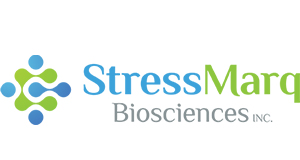TLR4 Antibody
Rabbit Anti-Human TLR4 Polyclonal
Artikelnummer
STRSPC-200D
Verpackungseinheit
100 µg
Hersteller
Stressmarq Biosciences
Verfügbarkeit:
wird geladen...
Preis wird geladen...
Target: TLR4
Conjugate: Unconjugated
Product Type: Polyclonal
Immunogen: Developed against a synthetic peptide corresponding to amino acids 420-435 of human TLR4
Swiss-Prot: O00206
Purification: Protein A Purified
Storage Buffer: PBS, 50% glycerol, 0.09% sodium azide *Storage buffer changes when conjugated
Concentration: 1 mg/ml
Specificity: Detects ~75-80kDa when tested against partial recombinant mouse TLR4 (extra-cellular portion plus His-tag).
Cellular Localization: Membrane
Scientific Background: The Toll-like receptor (TLR) family in mammal comprises a family of trans-membrane proteins characterized by multiple copies of leucine rich repeats in the extracellular domain and 1L-1 receptor motif in the cytoplasmic domain. Like its counterparts in Drosophila, TLRs signal through adaptor molecules (1). The TLR family is a phylo-genetically conserved mediator of innate immunity that is essential for microbial recognition (2). Ten human homologs of TLRs (TLR1-10) have been described (3). Amount this family of receptors, TLR2 and TLR4 have been most studied. These studies have suggested that TLR2 and TLR4 may serve as potential main mediators of LPS signaling (4,5). The mouse TLR4 cDNA codes for a protein consisting of 839 amino acids, with an approximate molecular weight of 90kDa (6).
References: 1. Muzio M., Natoli G., Saccan S., Levrero M., and Mantovani A. (1998) J. Exp. Med. 187: 2097-2101.2. Medzhitov R. and Janeway C.A (1997) Cell. 91: 295-298.3. Chuang T.H. and Ulevitch R.J. (2001) Biochim. Biophys. Acta. 1518(1-2): 157-161.4. Takeuchi O., et al. (1999) Immunity. 11: 443.5. Poltorak A., Riccardi-Castagnoli P., Citterio S., and Butler B. (2000) Proc. Natl. Acad. Sci USA. 97: 2163-2167.6. Medzhitov R., Preston-Hurlburt P. and Janeway C.A. (1997) Jr. Nature. 388(6640): 394-397.
Field of Use: Not for use in humans. Not for use in diagnostics or therapeutics. For in vitro research use only.
Conjugate: Unconjugated
Product Type: Polyclonal
Immunogen: Developed against a synthetic peptide corresponding to amino acids 420-435 of human TLR4
Swiss-Prot: O00206
Purification: Protein A Purified
Storage Buffer: PBS, 50% glycerol, 0.09% sodium azide *Storage buffer changes when conjugated
Concentration: 1 mg/ml
Specificity: Detects ~75-80kDa when tested against partial recombinant mouse TLR4 (extra-cellular portion plus His-tag).
Cellular Localization: Membrane
Scientific Background: The Toll-like receptor (TLR) family in mammal comprises a family of trans-membrane proteins characterized by multiple copies of leucine rich repeats in the extracellular domain and 1L-1 receptor motif in the cytoplasmic domain. Like its counterparts in Drosophila, TLRs signal through adaptor molecules (1). The TLR family is a phylo-genetically conserved mediator of innate immunity that is essential for microbial recognition (2). Ten human homologs of TLRs (TLR1-10) have been described (3). Amount this family of receptors, TLR2 and TLR4 have been most studied. These studies have suggested that TLR2 and TLR4 may serve as potential main mediators of LPS signaling (4,5). The mouse TLR4 cDNA codes for a protein consisting of 839 amino acids, with an approximate molecular weight of 90kDa (6).
References: 1. Muzio M., Natoli G., Saccan S., Levrero M., and Mantovani A. (1998) J. Exp. Med. 187: 2097-2101.2. Medzhitov R. and Janeway C.A (1997) Cell. 91: 295-298.3. Chuang T.H. and Ulevitch R.J. (2001) Biochim. Biophys. Acta. 1518(1-2): 157-161.4. Takeuchi O., et al. (1999) Immunity. 11: 443.5. Poltorak A., Riccardi-Castagnoli P., Citterio S., and Butler B. (2000) Proc. Natl. Acad. Sci USA. 97: 2163-2167.6. Medzhitov R., Preston-Hurlburt P. and Janeway C.A. (1997) Jr. Nature. 388(6640): 394-397.
Field of Use: Not for use in humans. Not for use in diagnostics or therapeutics. For in vitro research use only.
| Artikelnummer | STRSPC-200D |
|---|---|
| Hersteller | Stressmarq Biosciences |
| Hersteller Artikelnummer | SPC-200D |
| Verpackungseinheit | 100 µg |
| Mengeneinheit | STK |
| Reaktivität | Human, Mouse (Murine) |
| Klonalität | Polyclonal |
| Methode | Immunofluorescence, Western Blotting, Flow Cytometry, Immunohistochemistry, Immunocytochemistry, Fluorescence-Activated Cell Sorting (FACS) |
| Human Gene ID | 7099 |
| Wirt | Rabbit |
| Konjugat | Unconjugated |
| Produktinformation (PDF) | Download |
| MSDS (PDF) | Download |

 English
English







